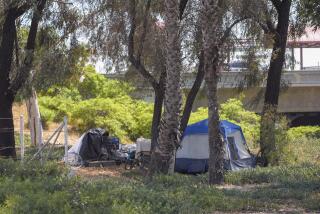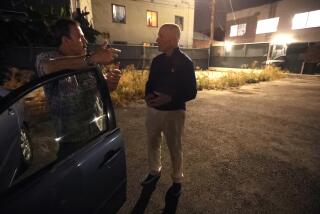Examining the Issues Behind NIMBY Positions
IRVINE — She started out studying homeless people, but Lois Takahashi now finds herself researching the mysteries of the NIMBY (Not In My Backyard) syndrome.
Takahashi, an assistant professor at UC Irvine’s department of urban and regional planning, has devoted the last seven years to probing a mentality manifested by decent people who become dead set against having less fortunate people move nearby.
The residents agree these people need help, as long as that help is not provided in their neighborhood. The problem then arises: Where should they go?
NIMBY pits advocates for needy groups, such as the homeless or people with AIDS, against residents who say they have to protect, among other things, their safety and their property values.
However, as Takahashi explained, those residents’ fears couldn’t be further from the truth.
After extensive research, she found that property values don’t go down around facilities for the needy.
“If it does, it’s because of the housing market prices,” Takahashi said.
Besides, she said, the homes for those requiring assistance “look beautiful. [The people being helped] are aware they’re on trial, so they take extra care in appearance and supervision.”
The heart of the issue, however, has nothing to do with declining property values or appearance, but with public attitudes toward these so-called intruders, she said.
When Takahashi began studying NIMBY, many people she interviewed told her that the main reason the residents were opposed was because they were just selfish.
“I just don’t buy the thought that these people opposing the facilities are selfish,” Takahashi said.
The reason, she said, is that the poor and needy carry a stigma. The homeless, for example, are wrongly associated with crime and deviant behavior, she said. “People are suffering from labels.”
Takahashi teaches three NIMBY-related classes at UCI, including a graduate-level course on community attitudes and oppositions, for a department founded less than four years ago. Her other classes, both undergraduate-level courses in urban geography and the sociological aspects of AIDS, each draw an estimated 300 students. She is currently on sabbatical from teaching to write a book about the syndrome and its many complications, due out in May 1998.
“When I first studied this area [NIMBY], I wanted to find an answer to the problem,” Takahashi said. “Now, I want to look more deeply and find out why these people think the way they do.”
Before she ever set foot on this subject, Takahashi was studying the homeless at the University of Southern California, when she found the two topics seemed to overlap. So she decided to change the focus of her study.
*
It was her drive and determination that piqued the interests of administrators at UCI and eventually brought her there in 1992 after receiving her doctorate.
“We saw an overall potential in her, a star potential,” said Luis Suarez-Villa, acting chairman of the department. “Her interests and specialization were important to have in our program.”
Suarez-Villa said that Takahashi is making a name for herself, as well as the young department, in academic ranks.
“It’s very rare for a distinguished publisher such as the Oxford University Press to offer a book contract to an assistant professor with no tenure,” he said. “This book will be very promising.”
In the meantime, Takahashi tries to enlighten students and readers about not only about the history of the syndrome, but also about possible solutions as well.
Although traces of the NIMBY syndrome have been around since the turn of the century, researchers believe the phenomenon took off during the 1980s, at the height of the “me” decade.
The syndrome, once associated with white suburban homeowners, began spreading across racial and class lines.
“NIMBY is affecting all different types of people. We saw mothers in East L.A. come out and protest against a proposed state prison in their area,” Takahashi said. “It’s much more complicated now.”
The growing number of cases has had its effects on society, signaling an end to an era when community once meant helping each other, said Michael Dear, a professor in the department of geography and director of the Southern California Studies Center at the USC.
“This behavior represents a collapse of the community in the classical sense, when every person in the community would take care of their own,” Dear said.
A study by Takahashi and Dear found that the Northeast region of the U.S. was the most accepting of these facilities, followed by the West, the Midwest and the South.
“The Northeast tends to be more liberal, they’re more aware of problems,” Takahashi said. “The West too is also more accepting, especially of AIDS and gay rights, while the Midwest and the South tend to be more traditional and less open to new ideas.”
As the problem escalates, researchers stress that public education and awareness are still the best antidote for NIMBY.
“We need to deal with it in the future by understanding it now,” said Takahashi, who added that community meetings and other town hall gatherings to discuss this issue can help change people’s attitudes. “The things we don’t know are the things we fear the most.
“I would rather live next to a homeless shelter or a home for people with AIDS than people I don’t know.”
More to Read
Sign up for Essential California
The most important California stories and recommendations in your inbox every morning.
You may occasionally receive promotional content from the Los Angeles Times.










